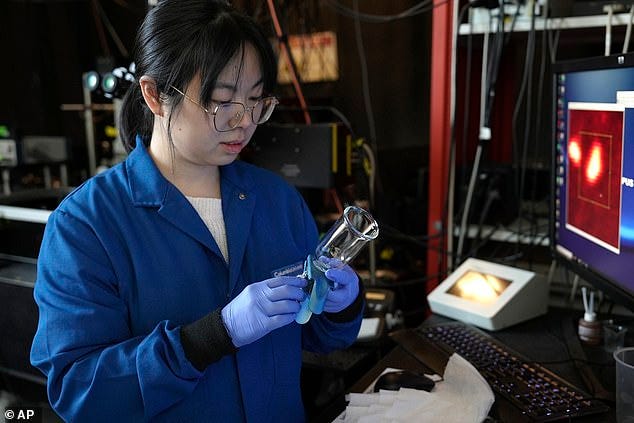Average bottle of water contains 240,000 pieces of cancer-causing nanoplastics - 100 times more than previously thought
One common type found of nanoparticle was polyethylene terephthalate or PET.
Bottles of plastic water contain hundreds of thousands of toxic microscopic plastic particles, new research has found.
The findings are likely to shock anyone who has swapped from tap to bottled water, believing it was better for their health.
Drinking water from a bottle could mean you are contaminating your body with tiny bits of plastic, which scientists fear can accumulate in your vital organs with unknown health implications.
Nanoplastics have already been linked to cancer, fertility problems and birth defects.
Scientists using the most advanced laser scanning techniques found an average of 240,000 plastic particles in a one-liter bottle of water, compared to 5.5 per one liter of tap water.
Drinking water from a bottle could mean you are contaminating your body with tiny bits of plastic, which scientists fear can accumulate in your vital organs with unknown implications for health
Scientists using the most advanced laser scanning techniques found an average of 240,000 plastic particles in a one-liter bottle of water, compared to 5.5 per one-liter of tap water
Scientists using the most advanced laser scanning techniques found an average of 240,000 plastic particles in a one-liter bottle of water, compared to 5.5 per one-liter of tap water
University of Columbia researchers tested three popular brands of bottled water sold in the United States – and, using lasers, analyzed the plastic particles they contained down to just 100 nanometers in size.
Ballet dancer, 10, dies from brain-eating amoeba she contracted while playing in a SWIMMING POOL on vacation
The particles – nanoplastics - are much smaller than the microplastics previously detected in bottled water.
However, the particles are considered potentially toxic because they are so small that they can enter directly into blood cells and the brain.
These microscopic particles carry phthalates — chemicals that make plastics more durable, flexible, and lasting longer.
Phthalate exposure is attributed to 100,000 premature deaths in the US each year. The chemicals are known to interfere with hormone production in the body.
They are 'linked with developmental, reproductive, brain, immune, and other problems', according to the National Institute of Environmental Health Sciences.
The highest estimates found 370,000 particles.
Nanoplastics had been too difficult to detect using conventional techniques, which could only find microplastics ranging from 5mm down to 1 micrometer – a millionth of a meter, or 1/25,000th of an inch. Nanoplastic particles are less than 1 micrometer across.
Groundbreaking research in 2018 found around 300 microplastic particles in a liter of bottled water – but researchers were limited by their measurement techniques at the time.
Research is now underway across the world to assess the potentially harmful effects.
The team used a new technique called Stimulated Raman Scattering (SRS) microscopy, which was recently invented by one of the paper's co-authors.
The method probes bottles with two lasers tuned to make specific molecules resonate, and a computer algorithm determines their origin.
The results showed that nanoparticles made up 90 percent of these molecules, and 10 percent were microplastics.
One common type found of nanoparticle was polyethylene terephthalate or PET.
Scientists using the most advanced laser scanning techniques found an average of 240,000 particles of plastic in a one-liter plastic bottle of water – thousands of times more particles than had been previously found
Study co-author Professor Beizhan Yan, an environmental chemist at Columbia, said: ‘This was not surprising, since that is what many water bottles are made of,’ said
He continued: ‘PET is also used for bottled sodas, sports drinks, and products such as ketchup and mayonnaise.
‘It probably gets into the water as bits slough off when the bottle is squeezed or gets exposed to heat.’
Another plastic particle found in bottles of water, and one which outnumbered PET, was polyamide – a type of nylon.
‘Ironically,’ said Professor Yan, ‘this probably comes from plastic filters used to supposedly purify the water before it is bottled.’
The other common plastics found included polystyrene, polyvinyl chloride (PVC), and polymethyl methacrylate, all of which are used in various industrial processes.
Go paid at the $5 a month level, and we will send you both the PDF and e-Pub versions of “Government” - The Biggest Scam in History… Exposed! and a coupon code for 10% off anything in the Government-Scam.com/Store.
Go paid at the $50 a year level, and we will send you a free paperback edition of Etienne’s book “Government” - The Biggest Scam in History… Exposed! AND a 64GB Liberator flash drive if you live in the US. If you are international, we will give you a $10 credit towards shipping if you agree to pay the remainder.
Support us at the $250 Founding Member Level and get a signed high-resolution hardcover of “Government” + Liberator flash drive + Larken Rose’s The Most Dangerous Superstition + Art of Liberty Foundation Stickers delivered anywhere in the world. Our only option for signed copies besides catching Etienne @ an event.








But what about all the Nano Tech it also contains... Why is nobody talking about That?